Lesson 4 制造要求
九年级英语:Unit 4 Inventions and Inventors(教学方案)
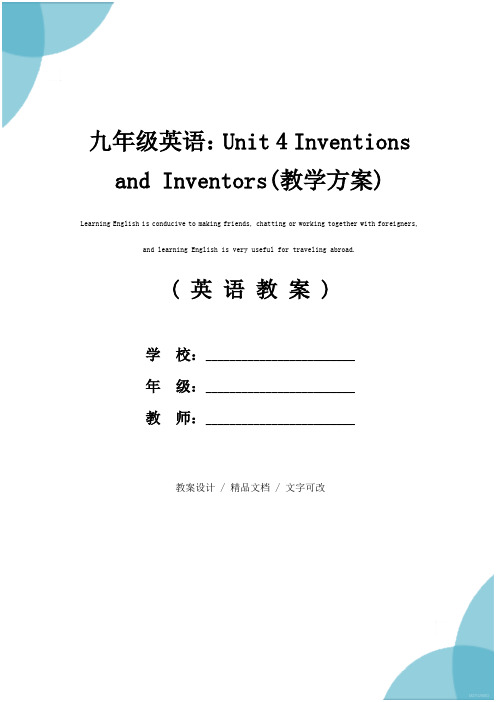
( 英语教案 )学校:_________________________年级:_________________________教师:_________________________教案设计 / 精品文档 / 文字可改九年级英语:Unit 4 Inventions and Inventors(教学方案) Learning English is conducive to making friends, chatting or working together with foreigners, and learning English is very useful for traveling abroad.九年级英语:Unit 4 Inventions andInventors(教学方案)unit 4 inventions and inventors【本讲教育信息】一. 教学内容:book 15 unit 4 (i)学会用动词的被动语态描述物体的使用方法,构成成份和功能作用。
二. 教学重点:1. 动词一般现在时被动语态。
2. 动词一般过去时被动语态。
3. 动词一般将来时被动语态。
4. 情态动词的被动语态5. 重点词汇三. 具体内容:(一)被动语态是动词的一种特殊形式,表示句子中的主语是动词的承受者,也就是动作的对象。
一般说来,只有需要动作对象的及物动词才有被动语态。
被动语态的用法:1)当我们不知道谁是动作的执行者时,或者没有必要指出谁是动作的执行者时,e.g. printing was introduced into europe from china.a new bridge will be built here next year.2)当我们关心动作的承受者但也关心动作的执行者时,用by 加动作的执行者。
e.g. the town was destroyed by an earthquake.英语动词的被动语态由助动词be+及物动词的过去分词构成。
新概念英语第一册Lesson4课件

新概念英语第一册Lesson4
1
of course 水壶 behind 茶壶 now 找到 boil
当然
kettle 在...后面 teapot 现在
find 沸腾,开
新概念英语第一册Lesson4
2
翻译
你会沏茶吗? Can you make the tea ? 水壶里面还有水吗? Is there any water in the kittle? 你能找得到吗? Can you find them ? 它在你前面. It's in front of you .
新概念英语第一册Lesson4
19
_____ _____ _______. Thank you ,Bob.
Bob ! Yes ? ____ _____ _____? I ____type this letter.
新概念英语第一册Lesson4
20
I can't read it ! The boss 's handwriting is ______.
新概念英语第一册Lesson4
Where is Pamela ? She is ___ ___ . She is ___ __ ____,sir.
新概念英语第一册Lesson4
18
Can she ___ this ___ for me ?Ask her please . Yes ,sir.
Can you type this letter for the _____please ,Pamela? Yes ,_____ _____ I can.
terrible['terəbl]
糟糕的
新概念英语第一册Lesson4
人教精通版四年级英语上册lesson4

通过生生对话,达到生生互动的目的,既提高了学生学习英语的兴趣,又巩固了新知。
通过自编对话,巩固和运用所学的单词及句型,同时提高学生的英语交际能力。
小组活动巩固复习
3min.
15min.
11min.
8min.
3.帮助孩子养成句子首字母需要大写的习惯,目前大部分同学没有意识。
5)鼓励学生自编Chant并提出要求:Chant要有助于学生记住单词的拼写和认读。
6)选取比较优秀的Chant进行展示,并用PPT出示老师自编Chant
1)出示课件,引导学生猜对话内容
2)引导学生观看动画
3)引导学生小组内练习对话,并分角色表演对话
1)教师鼓励学生在原对话的基础上自编新对话。
2)鼓励各小组派代表到讲台前表演自编对话
三会单词:postman
句型:What does your father do?
He is a …
语言技能:能够在真实语境中运用目标语言进行简单交流。
学习策略:愉快教学法、情境教学法、活动教学法、小组合作法、师生互动教学法。
文化意识:了解中西方职业的区别。
情感态度:培养学生学习英语的兴趣,使学生充满探求新知的欲望,树立学好英语的信心,提高交际能力,体验合作的成就感。
He is a …
教学反思
1.正确示范:teacher和postman,farmer三个四会单词的四线三格书写。让同学养成正确占格的习惯。
2.多给同学设计情景,在情境中去练习what does your father do?He isa…….,结合实际情况,增加对三个职业单词的印象,帮助同学快速记忆。
CQcreativity4
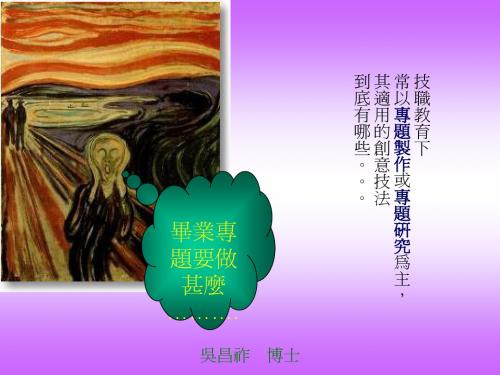
其 以
常 職 教 育 下 專 題 製 作 或 專 題
技
畢業專 題要做 甚麼 ……….
吳昌祚 博士
專題製作或研究之創意八法
找出產品的缺點、希望的優點及 是從一個與問題或題旨有關的列 腦力 改良的屬性等,進行修正設計 魚骨 表,來做旁敲側擊,尋找線索以 鯉鰲如是說 獲得觀念的方法 激盪法 圖法 指一個因可能產生很多個果, 或多個因可能產生一個果 發明創新題解理論,以問題分析 PERT法 卡片法 PERT法 工具與解題工具等科學方法進行 由多人對事情不同的理念下,互 以因果為主的資料流程進行發想,或 思考 相激盪,接龍方式想出點子 以特性為主的資料流程進行發想
轉速比
動力源種類
手排、自排、 手排、自排、混合
吳昌祚 博士
討論題
吳昌祚 博士
列舉法
檢核 表法
以書寫卡片方式,不受他人影 以時間為主的資料流程進行發想 響,表達點子
因果法
吳昌祚 博士
Байду номын сангаас
TRIZ法 TRIZ法
專題製作的步驟
成品的調整與檢測,應 主題設定、資料收集、製品構思 依故障檢修因素分析 產業界應朝跨科系 產品設計、作成計劃、實際測試 應由小組多 的開發 領域為宜 市場評價、產品分析 方討論 文件寫作、成果評估
特性Characteristics 特性Characteristics
設計要素間應具有適當的獨立性。 設計要素間應具有適當的獨立性 Design parameters should be independent of each other. 設計要素之組合應表現產品功能。 設計要素之組合應表現產品功能 The combination of design parameters should cover the function of the product. 設計要素之數目以四到七個為宜。 設計要素之數目以四到七個為宜 The number of design parameters is better to be 4 ~ 7.
新模式英语 Unit4 Lesson 4 We need furniture
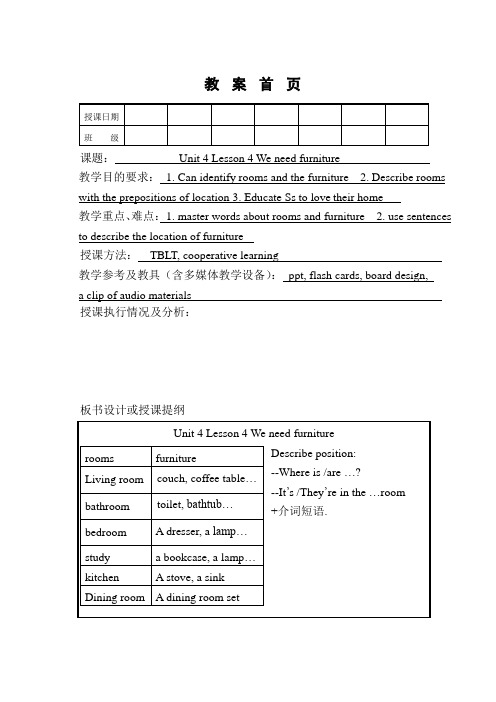
Board design: furniture words
describe and draw
read together andby takinga train ride
Work in pairs: making dialogs
教案首页
授课日期
班 级
课题:Unit 4 Lesson 4 We need furniture
教学目的要求:1. Can identifyrooms andthefurniture2. Describerooms
with the prepositions of location3. Educate Ss to lovetheir home
教学重点、难点:1. masterwords about rooms and e sentences to describe thelocationof furniture
授课方法:TBLT, cooperative learning
教学参考及教具(含多媒体教学设备):ppt,flashcards, board design,
3. Practice:
1) Complete the floor plan key with words from the box.
2) Look at the home plans. Which one is Kyung’s new home? (P70)
Study the furniture in each room
2. Report the list to the class.
3. Study the furniture words one by one with each picture:
Lesson 4 Teaching planing
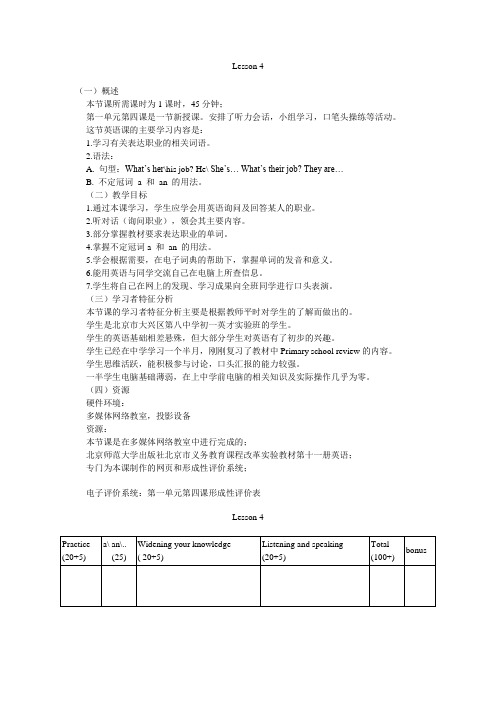
Lesson 4(一)概述本节课所需课时为1课时,45分钟;第一单元第四课是一节新授课。
安排了听力会话,小组学习,口笔头操练等活动。
这节英语课的主要学习内容是:1.学习有关表达职业的相关词语。
2.语法:A. 句型:What’s her\his job? He\ She’s… What’s their job? They are…B. 不定冠词a 和an 的用法。
(二)教学目标1.通过本课学习,学生应学会用英语询问及回答某人的职业。
2.听对话(询问职业),领会其主要内容。
3.部分掌握教材要求表达职业的单词。
4.掌握不定冠词a 和an 的用法。
5.学会根据需要,在电子词典的帮助下,掌握单词的发音和意义。
6.能用英语与同学交流自己在电脑上所查信息。
7.学生将自己在网上的发现、学习成果向全班同学进行口头表演。
(三)学习者特征分析本节课的学习者特征分析主要是根据教师平时对学生的了解而做出的。
学生是北京市大兴区第八中学初一英才实验班的学生。
学生的英语基础相差悬殊,但大部分学生对英语有了初步的兴趣。
学生已经在中学学习一个半月,刚刚复习了教材中Primary school review的内容。
学生思维活跃,能积极参与讨论,口头汇报的能力较强。
一半学生电脑基础薄弱,在上中学前电脑的相关知识及实际操作几乎为零。
(四)资源硬件环境:多媒体网络教室,投影设备资源:本节课是在多媒体网络教室中进行完成的;北京师范大学出版社北京市义务教育课程改革实验教材第十一册英语;专门为本课制作的网页和形成性评价系统;电子评价系统:第一单元第四课形成性评价表Lesson 4( 五)过程教学策略:创设情境→主体探索→口头操练→小组交流→成果汇报提出问题,提供电子网上资源,指导学生自主学习。
组织交流信息,进行分组合作学习。
学生活动:利用学习电子信息。
(信息加工策略)课上积极参与交流、评价。
(主动参与策略)与同组其他同学密切协作,交流所得信息。
新冀教版八年级上册英语 Lesson 4 教案
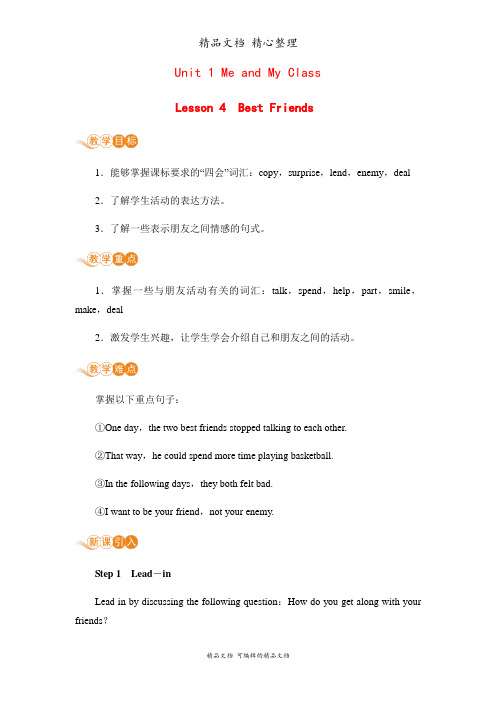
Unit 1 Me and My ClassLesson 4 Best Friends1.能够掌握课标要求的“四会”词汇:copy,surprise,lend,enemy,deal 2.了解学生活动的表达方法。
3.了解一些表示朋友之间情感的句式。
1.掌握一些与朋友活动有关的词汇:talk,spend,help,part,smile,make,deal2.激发学生兴趣,让学生学会介绍自己和朋友之间的活动。
掌握以下重点句子:①One day,the two best friends stopped talking to each other.②That way,he could spend more time playing basketball.③In the following days,they both felt bad.④I want to be your friend,not your enemy.Step 1Lead-inLead in by discussing the following question:How do you get along with your friends?Discuss in groups for three minutes.Then let some students present their answers in front of the class.Step 2ListeningListen to the tape and know about the main points of the passage.At the same time,fill in the blanks with the words you hear.1.Grant wanted to________ ________,so he didn’t want to do his homework.2.Patrick and Grand didn’t________ ________ each other for some days.3.They________ ________ ________at last and they were friends again.Finish the task in class in oral.Step 3ReadingRead the text and answer the following questions:1.Why did Patrick and Grant stop talking?2.How did Patrick feel at Grant’s words?3.What did Grant do at last?Read the text and finish the task in class in oral.Step 4PracticeAsk the students to write a short passage to introduce their best friends at school.Work in groups to finish the task.After a while,let some groups present their passages in front of the class.When the students are preparing,the teacher walks around the classroom to solve the problems that probably happen.Step 5 e to “Let’s Do It!”Listen to the tape and finish Exercise 1 together.Read the passage again and ask the students to answer the questions of Exercise 2.Finish off Exercise 3 in “Let’s Do It!”.。
《Lesson4 》 讲义
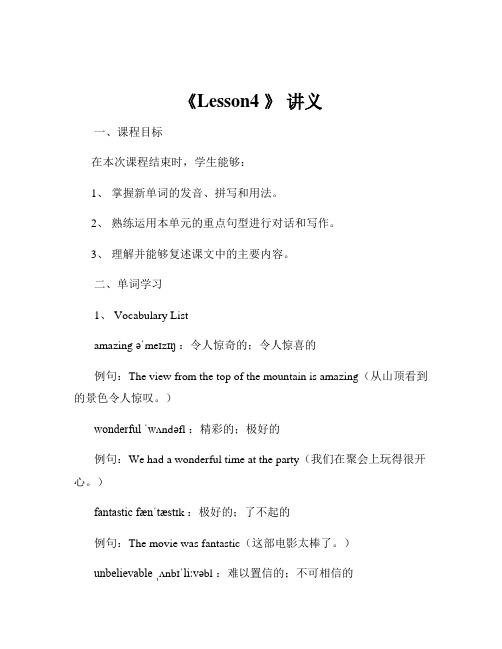
《Lesson4 》讲义一、课程目标在本次课程结束时,学生能够:1、掌握新单词的发音、拼写和用法。
2、熟练运用本单元的重点句型进行对话和写作。
3、理解并能够复述课文中的主要内容。
二、单词学习1、 Vocabulary Listamazing əˈmeɪzɪŋ :令人惊奇的;令人惊喜的例句:The view from the top of the mountain is amazing(从山顶看到的景色令人惊叹。
)wonderful ˈwʌndəfl :精彩的;极好的例句:We had a wonderful time at the party(我们在聚会上玩得很开心。
)fantastic fænˈtæstɪk :极好的;了不起的例句:The movie was fantastic(这部电影太棒了。
)unbelievable ˌʌnbɪˈliːvəbl :难以置信的;不可相信的例句:It's unbelievable that he won the first prize(他得了一等奖,真让人难以置信。
)2、 Word Practice请同学们分组进行单词拼写比赛,看哪个小组能够又快又准地拼写出这些单词。
用所给单词进行造句练习,加深对单词的理解和运用。
三、句型讲解1、 Key Sentence Structures“How + adj + be + sth?” 用于询问某物怎么样。
例句:How amazing is this book? (这本书多么令人惊奇啊!)“It's + adj +to do sth” 表示做某事是……的。
例句:It's wonderful to meet you (见到你真好。
)2、 Sentence Practice给出一些情景,让学生用所学句型进行对话练习。
情景:描述一次旅行经历。
学生 A: How amazing was your trip?学生 B: It was fantastic The scenery was unbelievable四、课文理解1、 Text Reading请同学们大声朗读课文,注意语音语调。
LESSON_4

LESSON 4Review materialReview questionsQuestion 1Calculate the missing amounts.a b c dSales € 240,000 € 75,000Cost of goods sold 42,000 268,000 46,000Gross profit 114,000 39,000Operating expenses 95,000 146,000Income (Loss) (€ 8,000) € 48,000 (€ 14,000)Source: Adapted from Larson, Kermit P., Tilly Jenson and Raymond F. Carroll,Fundamental Accounting Principles, Tenth Canadian Edition (Toronto: McGraw-HillRyerson, 2002), Exercise 6-11, page 303Question 2Prepare journal entries for March 20X6 to record the following transactions for a retailstore. Assume a perpetual inventory system.Mar. 2 Purchased merchandise from Blanton Company under the following terms:€3,600 invoice price, 2/15, n/60, FOB factory.3 Paid €200 for shipping charge s on the purchase of March 2.4 Returned to Blanton Company unacceptable merchandise that had an invoice price of €600.17 Sent a cheque to Blanton Company for the March 2 purchase, net of the returned merchandise and applicable discount.18 Purchased merchandise from Fleming Corp. under the following terms:€7,500 invoice price, 2/10, n/30, FOB destination.21 After brief negotiations, received from Fleming Corp. a €2,100 allowance onthe purchase of March 18.28 Sent a cheque to Fleming Corp. paying for the March 18 purchase, net of thediscount and the allowance.Source: Adapted from Larson 10e, Exercise 6-3, page 301Financial Accounting Fundamentals Review material 4 2Question 3Prepare General Journal entries to record the following perpetual system merchandisingtransactions of Minchew Company. (Use a separate account for each receivable andpayable; for example, record the purchase on May 2 in Accounts Payable-Mobley Co.).Minchew Company does not use supplemental records for inventory accounting.May 2 Purchased merchandise from Mobley Co. for €9,000 under credit terms of1/15, n/30, FOB factory.4 Sold merchandise to Cornerstone Co. for €1,200 under credit terms of 2/10,n/60, FOB shipping point. The merchandise had cost €750.4 Paid €150 for frei ght charges on the purchase of May 2.9 Sold merchandise that cost €1,800 for €2,400 cash.10 Purchased merchandise from Richter Co. for €3,450 under credit terms of 2/15,n/60, FOB destination.12 Received a €300 credit memorandum acknowledging the return of merchandise purchased on May 10.14 Received the balance due from Cornerstone Co. for the credit sale dated May4.15 Sold for cash a piece of office equipment for its original cost, €500.17 Paid the balance due to Mobley Co.18 Purchased €820 of clea ning supplies from A & Z Suppliers; terms n/15.20 Sold merchandise that cost €1,350 to Harrill Co. for €1,875 under credit termsof 2/15, n/60, FOB shipping point.22 Issued a €225 credit memorandum to Harrill Co. for an allowance on goodssold on May 20.23 Received a debit memorandum from Harrill Co. for an error that overstated thetotal invoice by €75.25 Paid Richter Co. the balance due.31 Received the balance due from Harrill Co. for the credit sale dated May 20.31 Sold merchandise that cost €4,800to Cornerstone Co. for €7,500 undercreditterms of 2/10, n/60, FOB shipping point.Source: Adapted from Larson 10e, Problem 6-1B, page 317Question 4Beamer Company’s ledger on July 31, the end of the fiscal year, includes the followingaccounts that have normal balances:Merchandiseinventory .......................................................... € 34,800Joy Beamer, capital.............................................................. .. 115,300Joy Beamer, withdrawals.......................................................4,000 Sales................................................................ ....................... 157,200Sales discounts............................................................ ........... 1,700Sales returns andallowances ................................................. 3,500Cost of goodssold ................................................................. 102,000Depreciation expense............................................................. 7,300Salaries expense.............................................................. ....... 29,500Miscellaneous expenses.........................................................2,000Financial Accounting Fundamentals Review material 4 3A physical count of the inventory discloses that the cost of the merchandise on hand is€32,900. Prepare the entry to record this information.Source: Adapted from Larson 10e, QS 6-5, page 299Question 5The following amounts taken from supplementary and accounting records summarizeTransfer Compan y’s merchandising activities during 20X7. Set upT-accounts forMerchandise Inventory and Cost of Goods Sold. Then record the summarized activitiesdirectly in the accounts and compute the account balances.Cost of merchandise sold to customers in salestr ansactions .................. € 186,000Merchandise inventory balance, Dec. 31,20X6...................................... 27,000Invoice cost of merchandise purchases.................................................... 190,500 Shrinkage determined on Dec. 31,20X7 (700)Cost oftransportation-in.................................................... ...................... 1,900Cost of merchandise returned by customers and restored to inventory... 2,200Purchase discountsreceived ............................................................ ........ 1,600Purchase returns and allowances received............................................... 4,100 Source: Adapted from Larson 10e, Exercise 6-13, page 303Question 6(a)The following closing entries for Sabba Co. were made on January 31, 20X6 the end ofits annual accounting period: Sales................................................................ ..................... 531,000Income Summary........................................................... 531,000To close temporary accounts with credit balances.IncomeSummary.............................................................. ... 548,750Cost of Goods Sold........................................................ 301,000 Sales Returns and Allowances....................................... 14,000Sales Discounts............................................................ .. 7,000Selling Expenses............................................................ 117,000General and Administrative Expenses........................... 109,000 Interest Expense. (750)To close temporary accounts with debit balancesRequiredUse the information in the closing entries to preparea. A calculation of net sales.b. A classified multiple-step statement of comprehensive income for the year.Source: Adapted from Larson 10e, Exercise 6-15, page 304Financial Accounting Fundamentals Review material 4 4Question 6(b)The following list of accounts is taken from the December 31, 20X5,unadjusted trialbalance of Perry Sales, a business that is owned by Deborah Perry. Assuming a perpetualinventory system:a. Prepare a work sheet.b. Prepare a multiple-step statement of comprehensive income for the year endedDecember 31, 20X5.c. Journalize the closing entries.Debit CreditCash ................................................................ .............. € 13,000Merchandise inventory ................................................. 1,000Prepaid selling expense................................................. 4,000 Equipment............................................................ ......... 20,000Accumulated depreciation, equipment ......................... € 4,500 Accounts payable..........................................................6,000Salariespayable 0Deborah Perry,capital .................................................. 22,800Deborah Perry, withdrawals ......................................... 1,800 Sales................................................................ .............. 429,000Sales returns and allowances ........................................ 16,500Sales discounts............................................................ .. 4,000Cost of goodssold ........................................................ 211,000 Sales salaries expense................................................... 47,000 Utilities expense, store.................................................. 14,000Other sellingexpenses .................................................. 35,000 Other administrative expenses...................................... 95,000Additional information:Accrued sales salaries amount to €1,600. Prepaid selling expenses of €2,000 haveexpired.Source: Adapted from Larson 10e, Exercise 6-17, page 305Financial Accounting Fundamentals Review material 4 5Question 7Journalize the following merchandising transactions for Scout Systems assuming:a. a periodic systemb. a perpetual system.Nov. 1 Scout Systems purchases merchandise for €1,400 on credit with terms of 2/10,n/30.5 Scout Systems pays for the previous purchase.7 Scout Systems receives payment for returned defective merchandise of €100that was purchased on November 1.10 Scout Systems pays €80 to haul merchandise to its store.13 Scout Systems sells merchandise for €1,500 on account. The cost of themerchandise was €750.16 A customer returns merchandise from the November 13 transaction. The returned item sold for €200 and cost €100. The item will be returned toinventory.Source: Adapted from Larson 10e, Exercise 6-18, page 305Question 8Ethics ChallengeClaire Phelps is a popular high school student who attends approximately four dances ayear at her high school. Each dance requires a new dress and accessories that necessitatea financial outlay of €100 to €200 per event. Claire’s parents inform her that she is “onher own” with respect to financing the dresses. After incurring a major withdrawal fromher savings for the first dance in her second year, Claire developed a different approach.She buys the dress on credit the week before the dance, wears it to the dance, and returnsthe dress the next week for a full refund on her charge card. Required1. Comment on the ethics exhibited by Claire and possible consequences of her actions.2. How does the store account for the dresses that Claire returns Financial Accounting Fundamentals Review material 4 6Review solutionsQuestion 1a b c dSales € 240,000 € 75,000 € 462,000 € 85,000Cost of goods sold 126,000 42,000 268,000 46,000Gross profit from sales € 114,000 € 33,000 € 194,000 € 39,000 Operating expenses 95,000 41,000 146,000 53,000Net Income (Loss) € 19,000 (€ 8,000) € 48,000 (€ 14,000)Question 220X6Mar. 2 Merchandise Inventory .................................... 3,600 Accounts Payable — Blanton Company.... 3,600Purchased merchandise on credit.3 Merchandise Inventory (200)Cash (200)Paid shipping charges on purchased merchandise.4 Accounts Payable — Blanton Company (600)Merchandise Inventory (600)Returned unacceptable merchandise.17 Accounts Payable — Blanton Company.......... 3,000Merchandise Inventory (60)Cash............................................................ 2,940Paid balance within the discount period (2%).18 Merchandise Inventory .................................... 7,500 Accounts Payable — Fleming Corp........... 7,500Purchased merchandise on credit.21 Accounts Payable — Fleming Corp................. 2,100 Merchandise Inventory .............................. 2,100Received an allowance on purchase.28 Accounts Payable — Fleming Corp................. 5,400 Merchandise Inventory. (108)Cash............................................................ 5,292Paid balance within the discount period (2%).Financial Accounting Fundamentals Review material 4 7Question 3MINCHEW COMPANYMay 2 Merchandise Inventory..................................... 9,000 Accounts Payable — Mobley Co............... 9,000Purchased goods on credit.4 Accounts Receivable — Cornerstone Co......... 1,200Sales ...........................................................1,200Sold goods on credit.4 Cost of Goods Sold. (750)Merchandise Inventory (750)To record the cost of the May 4 sale.4 Merchandise Inventory (150)Cash (150)Paid freight on incoming goods.9 Cash.................................................................. 2,400Sales ...........................................................2,400Sold goods for cash.9 Cost of Goods Sold. ......................................... 1,800 Merchandise Inventory............................... 1,800To record the cost of the May 9 sale.10 Merchandise Inventory..................................... 3,450 Accounts Payable — Richter Co................ 3,450Purchased goods on credit.12 Accounts Payable — Richter Co (300)Merchandise Inventory (300)Received credit memo.14 Cash.................................................................. 1,176Sales Discounts (24)Accounts Receivable — Cornerstone Co... 1,200Collected receivable within the 2% discount period.15 Cash (500)Office Equipment (500)To record sale of store equipment at cost.17 Accounts Payable — Mobley Co..................... 9,000 Merchandise Inventory. (90)Cash............................................................8,910Paid payable within the discount period; 1% × €9,000 = €90.Financial Accounting Fundamentals Review material 4 8May 18 Cleaning supplies inventory (820)Accounts payable — A & Z Suppliers (820)Purchased supplies on credit.20 Accounts Receivable — Harrill Co.................. 1,875Sales ...........................................................1,875Sold goods on credit.20 Cost of Goods Sold. ......................................... 1,350 Merchandise Inventory............................... 1,350To record the cost of the May 20 sale.22 Sales Returns and Allowances (225)Accounts Receivable — Harrill Co. (225)Issued credit memo.23Sales ............................................................... .. 75Accounts Receivable — Harrill Co. (75)Received debit memo for error.25 Accounts Payable — Richter Co...................... 3,150 Merchandise Inventory. (63)Cash............................................................3,087Paid payable within the discount period; 2% × €3,150.31 Cash.................................................................. 1,Sales Discounts ................................................ Accounts Receivable — Harrill Co. .......... 1,575Collected receivable within the 2% discount period.31 Accounts Receivable — Cornerstone Co. ....... 7,500Sales ...........................................................7,500Sold goods on credit31 Cost of Goods Sold. ......................................... 4,800 Merchandise Inventory............................... 4,800To record the cost of the May 31 sale.Question 4BEAMER COMPANYJuly 31 Cost of Goods Sold ......................................... 1,900Merchandise Inventory .............................. 1,900€34,800 –€32,900 = €1,900Financial Accounting Fundamentals Review material 4 9Question 5TRANSFER COMPANYMerchandise InventoryBalance, Dec. 31, 20X6 ........ 27,000 Purchase discountsreceived ......... 1,600Invoice cost of purchases....... 190,500 Purchase returns and allowances Returns by customers ............ 2,200received .................................... 4,100Transportation-in .................. 1,900 Cost of salestransactions ............. 186,000Shrinkage (700)Total ...................................... 221,600Total ............................................. 192,400–192,400Balance, Dec. 31, 20X7 ......... 29,200Cost of Goods SoldRepresents all entries torecord the cost componentof sales transactions ...............186,000Represents all entries to recordmerchandise returnedby customers and restored toinventory during 20X7..................2,200Inventory shrinkagerecorded in December 31,20X7, adjusting entry.............700Total ...................................... 186,700Total ............................................. 2,200–2,200Balance ................................. 184,500Question 6(a)a. 531,000 – 14,000 – 7,000 = 510,000b.SABBA CO.Statement of Comprehensive Incomefor year ended January 31, 20X6 Sales................................................................ ........... € 531,000Less: Sales returns and allowances..................... € 14,000 Sales discounts .......................................... 7,000 21,000 Net sales...............................................................€ 510,000Cost of goods sold ..................................................... 301,000Gross profit from sales .............................................. € 209,000Operating expenses:...................................................Selling expe nses................................................... € 117,000General and administrative expenses................... 109,000Total operating expenses ..................................... 226,000 Loss from operations ........................................... € 17,000Other revenues and expenses:..............................Interest expense (750)Netloss ................................................................ ...... € 17,750Question 6(b)Part aPERRY SALESWork Sheetfor year ended December 31, 20X5UnadjustedTrial BalanceAdjustmentsStatement ofComprehensiveIncomeStatement ofFinancial Positionand Statement ofChanges inOwner’s EquityAccountDebit Credit Debit Credit Debit Credit Debit Credit Cash 13,000 13,000Merchandise inventory 1,000 1,000Prepaid selling expenses 4,000 2,000 2,000 Equipment 20,000 20,000Accumulated depreciation, equipment 4,500 4,500 Accounts payable 6,000 6,000Salaries payable 0 1,600 1,600Deborah Perry, capital 22,800 22,800Deborah Perry, withdrawals 1,800 1,800Sales 429,000 429,000Sales returns and allowances 16,500 16,500Sales discounts 4,000 4,000Cost of goods sold 211,000 211,000Sales salaries expense 47,000 1,600 48,600Utilities expense, store 14,000 14,000Other selling expenses 35,000 2,000 37,000Other administrative expenses 95,000 95,000Totals 462,300 462,300 3,600 3,600 426,100 429,000 37,800 34,900Net Income 2,900 2,900Totals 429,000 429,000 37,800 37,800Financial Accounting Fundamentals Review material 4 10Financial Accounting Fundamentals Review material 4 11Part bPERRY SALESStatement of Comprehensive Incomefor year ended December 31, 20X5 Sales............................................................... € 429,000Less: Sal es returns and allowances............... € 16,500Sales discounts .................................... 4,000 20,500Net sales......................................................... € 408,500Cost of goods sold ......................................... 211,000 Gross profit from sales .................................. € 197,500 Operating expenses:Selling expenses:Sales salaries expense .......................... € 48,600Utilities expense, store ......................... 14,000Other selling expenses ......................... 37,000Total selling expenses .......................... € 99,600General and administrative expenses: ..... 95,000Total operating expenses ......................... 194,600Net income..................................................... €2,900Part cClosing entries20X5Dec. 31 Sales ..................................................... 429,000Income Summary............................ 429,000To close sales.31 Income Summary.................................. 426,100Sales Returns and Allowances........ 16,500Sales Discounts............................... 4,000Cost of Goods Sold......................... 211,000Sales Salaries Expense.................... 48,600Utilities Expense............................. 14,000Selling Expenses............................. 37,000Administrative Expenses ................ 95,000To close temporary debit balance accounts.31 Income Summary.................................. 2,900Deborah Perry, Capital ................... 2,900To close the Income Summary account to capital.31 Deborah Perry, Capital ......................... 1,800Deborah Perry, Withdrawals .......... 1,800To close withdrawals to capitalFinancial Accounting Fundamentals Review material 4 12Question 7Scout Systems Scout Systems1. Periodic PerpetualNov. 1 Purchases..................................... 1,400 Merchandise Inventory................ 1,400Accounts Payable ................ 1,400 Accounts Payable ................ 1,400 To record purchases onaccount.To record merchandiseacquisitions on account.2.Nov. 5 Accounts Payable ........................ 1,400 AccountsPayable ........................ 1,400Purchases Discount.............. 28 Merchandise Inventory.. (28)Cash..................................... 1,372 Cash..................................... 1,372To record cash payment withindiscount period.To record cash payment withindiscount period.3.Nov. 7 Cash (98)Cash (98)Purchases Returns andAllowances .....................98 Merchandise Inventory........To record cheque received for98To record cheque received forreturn of purchases previouslypaid for with discount alreadytaken.return of merchandisepreviously paid for withdiscount already taken.4.Nov. 10 Transportation-In......................... 80 Merchandise Inventory. (80)Cash (80)Cash (80)To record payment of freightcharges.To record payment of freightcharges.5.Nov. 13 Accounts Receivable ................... 1,500 Accounts Receivable................... 1,500Sales .................................... 1,500Sales .................................... 1,500To record sale of merchandiseon credit.To record sale of merchandiseon credit.13 Cost of Goods Sold (750)Merchandise Inventory (750)To record cost of merchandisesold.6.Nov. 16 Sales Returns and Allowances .... 200 Sales Returns and Allowances .. (200)Accounts Receivable ........... 200 Accounts Receivable .. (200)To record return of merchandisebought on account.To record return of merchandisebought on account.16 Merchandise Inventory (100)Cost of Goods Sold (100)To record return of merchandiseby customer.Financial Accounting Fundamentals Review material 4 13Question 8Ethics Challenge1. Some students may feel that Claire has devised a clever way to save money. Sheappears to be succeeding in getting something for free. Other students will feel thatClaire is definitely abusing the system and that her ethical code needs a major review.However, it is important to point out that customer abuses such as Claire’s usuallyresult in stores adopting stringent return policies that will impact all customers whohave legitimate needs to return unused products. At some point, Clairewill probablysuffer discomfort when questioned about items that are returned in less than perfectcondition. Also, if st ore managers suspect Claire’s behaviour over time, they may nolonger allow her to shop at their store. If Claire is banned from the store, she willlikely suffer humiliation for herself and her family. Claire’s parents probably do notknow of her scheme and she may suffer additional consequences once they learn ofher practices.2. The store must account for sales returns using a contra-revenue account called Salesreturns and allowances. A dress returned with a sales bill of €100 would be accountedfor as follows (assume the cost of sales was 60% or €60 and that the dress wasreturned to inventory):Sales returns and allowances (100)Accounts receivable (100)Cost of goods sold (60)Merchandise inventory (60)If the dress were not returned to inventory, the second entry would not be required.Financial Accounting Fundamentals Review material 5 1。
三年级英语上册Lesson 4 A box教学设计2-接力版
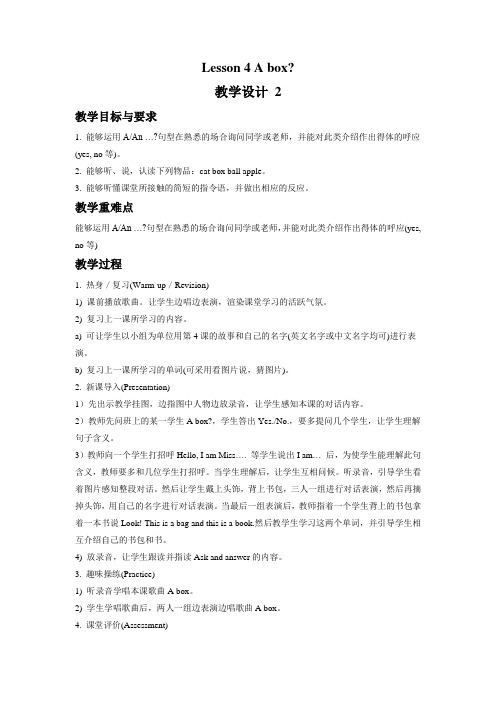
Lesson 4 A box?教学设计 2教学目标与要求1. 能够运用A/An …?句型在熟悉的场合询问同学或老师,并能对此类介绍作出得体的呼应(yes, no等)。
2. 能够听、说,认读下列物品:cat box ball apple。
3. 能够听懂课堂所接触的简短的指令语,并做出相应的反应。
教学重难点能够运用A/An …?句型在熟悉的场合询问同学或老师,并能对此类介绍作出得体的呼应(yes, no等)教学过程1. 热身/复习(Warm-up/Revision)1) 课前播放歌曲。
让学生边唱边表演,渲染课堂学习的活跃气氛。
2) 复习上一课所学习的内容。
a) 可让学生以小组为单位用第4课的故事和自己的名字(英文名字或中文名字均可)进行表演。
b) 复习上一课所学习的单词(可采用看图片说,猜图片)。
2. 新课导入(Presentation)1)先出示教学挂图,边指图中人物边放录音,让学生感知本课的对话内容。
2)教师先问班上的某一学生A box?,学生答出Yes./No.,要多提问几个学生,让学生理解句子含义。
3)教师向一个学生打招呼Hello, I am Miss…. 等学生说出I am…后,为使学生能理解此句含义,教师要多和几位学生打招呼。
当学生理解后,让学生互相问候。
听录音,引导学生看着图片感知整段对话。
然后让学生戴上头饰,背上书包,三人一组进行对话表演,然后再摘掉头饰,用自己的名字进行对话表演。
当最后一组表演后,教师指着一个学生背上的书包拿着一本书说Look! This is a bag and this is a book.然后教学生学习这两个单词,并引导学生相互介绍自己的书包和书。
4) 放录音,让学生跟读并指读Ask and answer的内容。
3. 趣味操练(Practice)1) 听录音学唱本课歌曲A box。
2) 学生学唱歌曲后,两人一组边表演边唱歌曲A box。
4. 课堂评价(Assessment)本课为第二单元的第一课,可在做练习之前与学生商量本单元获奖的数量,可在上一单元的基础上适当增加。
lesson4电子教案

------For your health my boy.
A play B to play C to playing D playing
2.2.tr translate these sentences and then try to summarize the usage of “lend”
a.I won’tlendyou my homework.
T: Can you finish the following exercises?
Jenny-_____(借给)her CD_____me yesterday.
Learning Tips: Take notes. Ask questions if you don’t understand.
第四步:能力提升,学以致用(20 mins)
4、写:能写出有意义的句子表达自己观点。
情感态度
Emotion and Attitude
1、培养学生学英语的兴趣、信心和勇气,敢于用英语表达自己的思想。
2、懂得什么是真正的好朋友以及如何勇于拒绝不合理的要求。
教学重点
Teaching Important Points
1.目标语言的掌握。
2.语言技能的提高。
to one’s surprise让某人吃惊的是
at the end of在……最后,末尾
2. stop to do sth.停下来开始做某事
《Lesson 4 》 说课稿
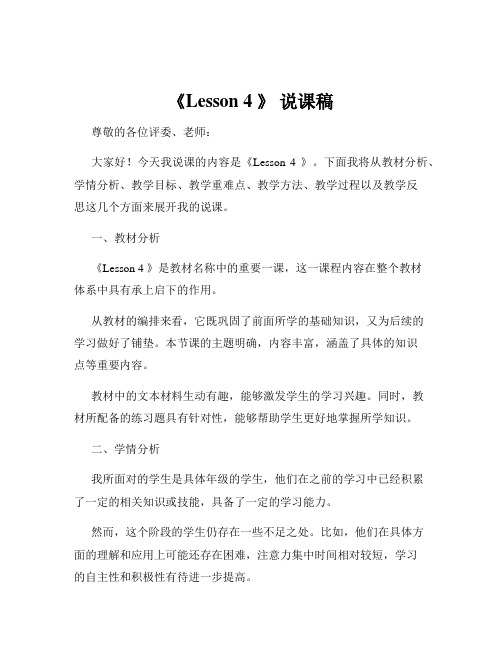
《Lesson 4 》说课稿尊敬的各位评委、老师:大家好!今天我说课的内容是《Lesson 4 》。
下面我将从教材分析、学情分析、教学目标、教学重难点、教学方法、教学过程以及教学反思这几个方面来展开我的说课。
一、教材分析《Lesson 4 》是教材名称中的重要一课,这一课程内容在整个教材体系中具有承上启下的作用。
从教材的编排来看,它既巩固了前面所学的基础知识,又为后续的学习做好了铺垫。
本节课的主题明确,内容丰富,涵盖了具体的知识点等重要内容。
教材中的文本材料生动有趣,能够激发学生的学习兴趣。
同时,教材所配备的练习题具有针对性,能够帮助学生更好地掌握所学知识。
二、学情分析我所面对的学生是具体年级的学生,他们在之前的学习中已经积累了一定的相关知识或技能,具备了一定的学习能力。
然而,这个阶段的学生仍存在一些不足之处。
比如,他们在具体方面的理解和应用上可能还存在困难,注意力集中时间相对较短,学习的自主性和积极性有待进一步提高。
但学生们具有较强的好奇心和求知欲,对于新鲜的事物充满兴趣。
只要能够激发他们的学习热情,引导他们积极参与课堂活动,就能够取得良好的教学效果。
三、教学目标基于对教材和学情的分析,我制定了以下教学目标:1、知识目标学生能够掌握具体的词汇、句型、语法等知识,理解课文的主要内容。
2、技能目标通过课堂练习和活动,培养学生的听、说、读、写等技能,提高他们运用所学知识进行交流和表达的能力。
3、情感目标激发学生对相关主题的兴趣,培养他们的合作精神、学习兴趣等情感态度。
四、教学重难点1、教学重点明确本节课的重点知识和技能,如重点词汇、关键句型等2、教学难点分析学生在学习过程中可能遇到的困难,如复杂的语法结构、抽象的概念等五、教学方法为了实现教学目标,突破教学重难点,我将采用以下教学方法:1、情景教学法通过创设生动的情景,让学生在真实的语境中感受和学习语言,提高他们的语言运用能力。
2、任务驱动法布置各种任务,让学生在完成任务的过程中主动学习,培养他们的自主学习能力和合作精神。
《Lesson 4》 教学设计
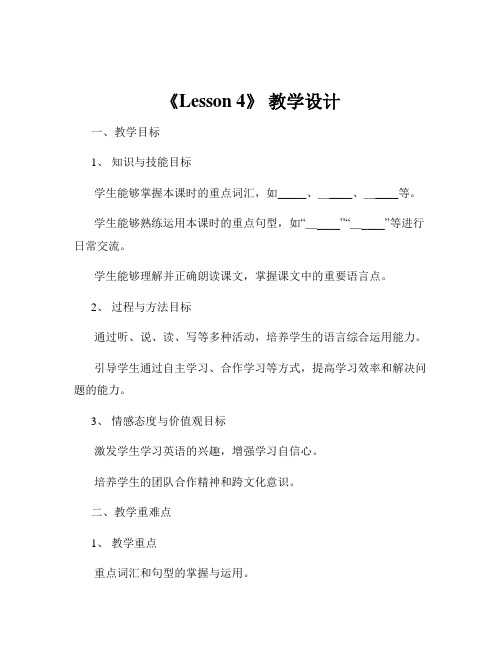
《Lesson 4》教学设计一、教学目标1、知识与技能目标学生能够掌握本课时的重点词汇,如_____、_____、_____等。
学生能够熟练运用本课时的重点句型,如“_____”“_____”等进行日常交流。
学生能够理解并正确朗读课文,掌握课文中的重要语言点。
2、过程与方法目标通过听、说、读、写等多种活动,培养学生的语言综合运用能力。
引导学生通过自主学习、合作学习等方式,提高学习效率和解决问题的能力。
3、情感态度与价值观目标激发学生学习英语的兴趣,增强学习自信心。
培养学生的团队合作精神和跨文化意识。
二、教学重难点1、教学重点重点词汇和句型的掌握与运用。
课文的理解和朗读。
2、教学难点如何让学生在实际情境中灵活运用所学知识进行交流。
对某些语法点的准确理解和运用,如_____。
三、教学方法1、情景教学法通过创设生动有趣的情景,让学生在实际情境中学习和运用语言。
2、任务驱动法布置明确的任务,让学生在完成任务的过程中提高语言能力。
3、小组合作学习法组织学生进行小组合作学习,培养学生的团队合作精神和交流能力。
四、教学过程1、导入(5 分钟)通过播放一段与本课时主题相关的英语视频或展示一些图片,引起学生的兴趣,导入新课。
提问学生关于视频或图片的内容,引导学生用已学知识进行回答。
2、词汇学习(10 分钟)展示本课时的重点词汇,通过图片、实物、动作等方式帮助学生理解词汇的含义。
带领学生朗读词汇,纠正发音。
进行简单的词汇练习,如单词拼写、英汉互译等。
3、句型学习(10 分钟)呈现重点句型,讲解句型的结构和用法。
创设情境,让学生进行句型操练,如模仿对话、角色扮演等。
4、课文学习(15 分钟)播放课文录音,让学生边听边理解课文大意。
带领学生逐句朗读课文,讲解课文中的语言点和难点。
让学生分组朗读课文,互相纠正发音和语调。
5、语言运用(10 分钟)布置任务,让学生根据课文内容或给定的情境,进行对话创作。
学生分组展示对话,其他小组进行评价和补充。
新职业英语基础篇Unit4教案
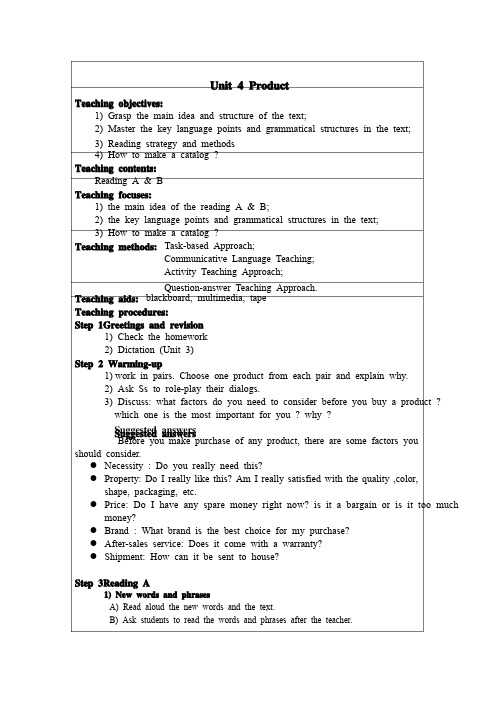
Unit 4 ProductTeaching objectives:1) Grasp the main idea and structure of the text; 2) Master the key language points and grammatical structures in the text; 3) Reading strategy and methods 4) How to make a catalog ? Teaching contents:Reading A & B Teaching focuses:1) the main idea of the reading A & B; 2) the key language points and grammatical structures in the text; 3) How to make a catalog ? Teaching methods: Task-based Approach; Communicative Language Teaching; Activity Teaching Approach; Question-answer Teaching Approach. Teaching aids: blackboard, multimedia, tape Teaching procedures:1Step 1Greetings Greetings and revision1) Check the homework 2) Dictation (Unit 3) Step 2 Warming-up1)work in pairs. Choose one product from each pair and explain why. 2) Ask Ss to role-play their dialogs. 3) Discuss: what factors do you need to consider before you buy a product ? which one is the most important for you ? why ? Suggested answers : Before Before you you you make make make purchase purchase purchase of of of any any any product, product, product, there there there are are are some some some factors factors factors you you should consider. l Necessity : Do you really need this? l Property: Property: Do Do Do I I I really really really like like like this? this? this? Am Am Am I I I really really really satisfied satisfied satisfied with with with the the the quality quality quality ,color, ,color, shape, packaging, etc. l Price: Do I have any spare money right now? is it a bargain or is it too much money? l Brand : What brand is the best choice for my purchase? l After-sales service: Does it come with a warranty? l Shipment: How can it be sent to house? Step 33Reading Reading A1) New words and phrasesA) Read aloud the new words and the text.B) Ask students to read the words and phrases after the teacher. 2) SkimmingA) Ask students to read the text as quickly as they can and tried to get the main idea of this passage. B) Ask students to read the text again , then finish Task1 on P52 3) Language points① I ’d design analarm clock with a moving with a moving snooze button that would be an easy target the first first time time time I I I hit hit hit it. it. it. Then Then Then it it it becomes becomes becomes harder harder harder to to locate after after each each attempt , , so so so that that that it it it would would would keep keep ringing until I ’m fully awake. alarm n. 警报,警告器;惊慌警报,警告器;惊慌e.g. 1. I felt a growing sense of alarm when he didn't return that night. 2. She decided to sound the alarm. 她决定发出警报。
《Lesson 4 》 说课稿
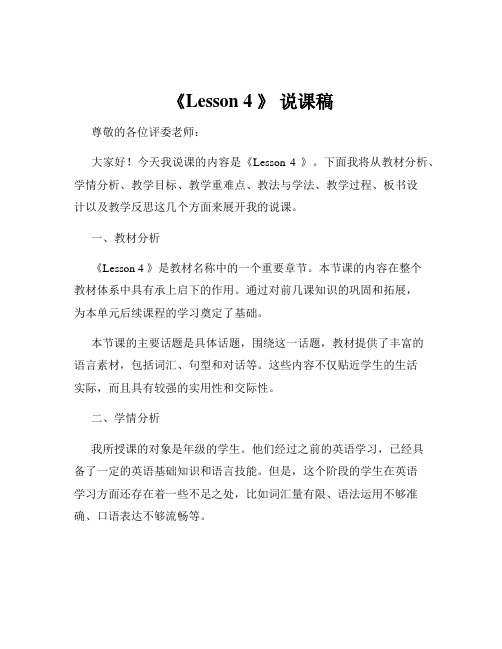
《Lesson 4 》说课稿尊敬的各位评委老师:大家好!今天我说课的内容是《Lesson 4 》。
下面我将从教材分析、学情分析、教学目标、教学重难点、教法与学法、教学过程、板书设计以及教学反思这几个方面来展开我的说课。
一、教材分析《Lesson 4 》是教材名称中的一个重要章节。
本节课的内容在整个教材体系中具有承上启下的作用。
通过对前几课知识的巩固和拓展,为本单元后续课程的学习奠定了基础。
本节课的主要话题是具体话题,围绕这一话题,教材提供了丰富的语言素材,包括词汇、句型和对话等。
这些内容不仅贴近学生的生活实际,而且具有较强的实用性和交际性。
二、学情分析我所授课的对象是年级的学生。
他们经过之前的英语学习,已经具备了一定的英语基础知识和语言技能。
但是,这个阶段的学生在英语学习方面还存在着一些不足之处,比如词汇量有限、语法运用不够准确、口语表达不够流畅等。
在学习风格上,年级的学生具有较强的好奇心和求知欲,喜欢通过多种方式来获取知识。
因此,在教学过程中,我将采用多样化的教学方法和手段,激发学生的学习兴趣,提高他们的学习积极性。
三、教学目标基于对教材和学情的分析,我制定了以下教学目标:1、知识目标(1)学生能够掌握本节课的重点词汇,如词汇 1、词汇 2、词汇 3等。
(2)学生能够熟练运用本节课的重点句型,如句型 1、句型 2、句型 3等进行日常交流。
2、技能目标(1)通过听、说、读、写等多种训练方式,提高学生的英语综合运用能力。
(2)培养学生的口语表达能力和阅读理解能力,使学生能够用英语进行简单的对话和描述。
3、情感目标(1)激发学生学习英语的兴趣,增强他们的学习自信心。
(2)培养学生的合作意识和团队精神,让学生在学习中体验到成功的喜悦。
四、教学重难点1、教学重点(1)掌握本节课的重点词汇和句型。
(2)能够运用所学知识进行简单的日常交流。
2、教学难点(1)如何让学生正确运用所学句型进行表达,尤其是在语境中的灵活运用。
《Unit 4 Making Arrangements Problem Solving》教学设计教学
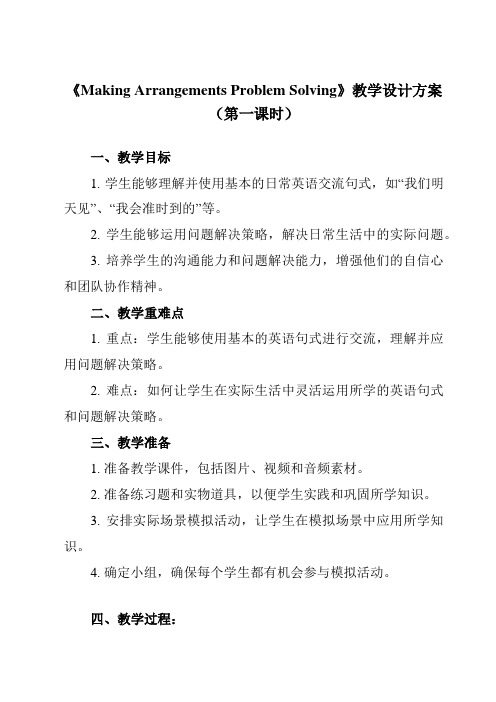
《Making Arrangements Problem Solving》教学设计方案(第一课时)一、教学目标1. 学生能够理解并使用基本的日常英语交流句式,如“我们明天见”、“我会准时到的”等。
2. 学生能够运用问题解决策略,解决日常生活中的实际问题。
3. 培养学生的沟通能力和问题解决能力,增强他们的自信心和团队协作精神。
二、教学重难点1. 重点:学生能够使用基本的英语句式进行交流,理解并应用问题解决策略。
2. 难点:如何让学生在实际生活中灵活运用所学的英语句式和问题解决策略。
三、教学准备1. 准备教学课件,包括图片、视频和音频素材。
2. 准备练习题和实物道具,以便学生实践和巩固所学知识。
3. 安排实际场景模拟活动,让学生在模拟场景中应用所学知识。
4. 确定小组,确保每个学生都有机会参与模拟活动。
四、教学过程:1. 导入环节:教师向学生介绍本堂课的学习主题“making arrangements”,并通过图片或视频展示,帮助学生回忆以往的相关经验和知识。
教师可以引导学生谈论自己或他人的住宿、出行、聚会等安排经历,进一步熟悉相关词汇和表达方式。
2. 热身环节:教师设计一些简单的互动活动,如单词接龙、小组讨论等,以激活学生的学习热情和动力。
同时,教师也可以通过播放一些与本堂课主题相关的英文歌曲或视频,帮助学生进入英语语境,提高学习兴趣。
3. 新课呈现:教师通过PPT或视频展示,介绍问题解决的方法和策略,如分析问题、制定计划、实施计划、评估结果等。
教师引导学生思考并讨论日常生活中可能遇到的安排问题,如宿舍分配、课程调整、时间管理、交通安排等。
学生以小组为单位,运用所学知识和技能,共同探讨解决方案。
4. 实践环节:教师为学生提供一些真实的案例或场景,如校园生活中的实际安排问题,让学生运用所学知识和技能进行实践操作。
学生需要使用英语进行讨论和决策,提高英语口语和书面表达能力。
教师对学生的实践过程进行观察和指导,及时给予反馈和建议。
Lesson4SoilPrope...
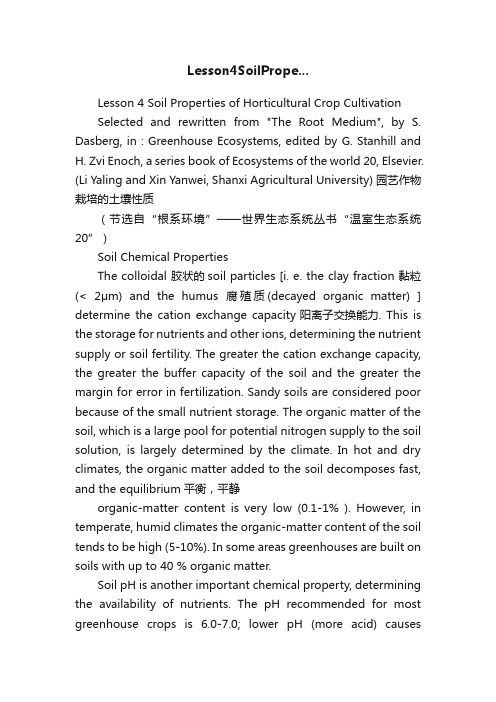
Lesson4SoilPrope...Lesson 4 Soil Properties of Horticultural Crop CultivationSelected and rewritten from "The Root Medium", by S. Dasberg, in:Greenhouse Ecosystems, edited by G. Stanhill and H. Zvi Enoch, a series book of Ecosystems of the world 20, Elsevier. (Li Yaling and Xin Yanwei, Shanxi Agricultural University) 园艺作物栽培的土壤性质(节选自“根系环境”——世界生态系统丛书“温室生态系统20”)Soil Chemical PropertiesThe colloidal 胶状的soil particles [i. e. the clay fraction 黏粒(< 2μm) and the humus腐殖质(decayed organic matter) ] determine the cation exchange capacity阳离子交换能力. This is the storage for nutrients and other ions, determining the nutrient supply or soil fertility. The greater the cation exchange capacity, the greater the buffer capacity of the soil and the greater the margin for error in fertilization. Sandy soils are considered poor because of the small nutrient storage. The organic matter of the soil, which is a large pool for potential nitrogen supply to the soil solution, is largely determined by the climate. In hot and dry climates, the organic matter added to the soil decomposes fast, and the equilibrium平衡,平静organic-matter content is very low (0.1-1% ). However, in temperate, humid climates the organic-matter content of the soil tends to be high (5-10%). In some areas greenhouses are built on soils with up to 40 % organic matter.Soil pH is another important chemical property, determining the availability of nutrients. The pH recommended for most greenhouse crops is 6.0-7.0; lower pH (more acid) causesaluminum铝and manganese锰toxicity毒性, while higher pH (more alkaline) causes precipitation沉淀of phosphorus and problems with micronutrient uptake. On soils high in organic matter, pH values of 5-6 are advised. Soil pH can be increased by liming撒石灰, and can be decreased by proper composition of the nutrient solution. Changes in soil pH are very slow because of the large buffer capacity of natural soils.Soil salinity盐分affects plant growth by increasing the osmotic potential 渗透势of the soil solution, causing plant water stress水分胁迫and decreasing water uptake. Specific ions特殊离子may cause toxic effects. Soils containing soluble salts,giving an electrical conductivity 电导率(EC) above 3-4 dS·m-1 (mS·cm-1) in the saturation extract饱和提取液, are not suitable for greenhouse culture. Forsalt-sensitive plants, even lower threshold values阈值apply. Excess salts should be leached过滤from the soil prior to greenhouse construction. Problems of salinity are associated in many cases with the quality of irrigation water.Soil Physical PropertiesThe soil is a three-phase system, that consists of solid particles (the soil matrix) and voids (the soil pores), that may either be filled with water or with air. Hence, distinction is made between a solid, a liquid and a gaseous phase, respectively.The distribution between the three phases depends on the composition of the solid phase, particularly on the particle size distribution of the soil, which is denoted as the soil texture结构. There are three particle size classes distinguished: < 0. 002, 0. 002-0. 05 and 0.05-2 mm, defined as clay, silt, and sand, respectively. The ratio between these fractions classifies the texture of the soil of interest according to the texture triangle土壤质地三角图.Soils with high clay content (containing more than 40% particles <0. 002mm diameter) are more difficult to handle, tend to hold excess water and drain slowly, and are therefore less suitable for greenhouse culture. On the other hand, sandy soils (containing more than 90% particles >2 mm) are less fertile, have a low water capacity and need better fertilization and frequent irrigation. The most important soil physical property is soil structure, this being the nature and stability of the bonds between soil particles, causing aggregation集合, 聚合and large soil pores. Good and stable soil structure is enhanced by organic matter, which should be added to the soil if not present originally. Soil texture and structure determine the rate of water movement in the soil, the water holding capacity and the drainage. Soils which tend to drain slowly show aeration problems, since soilpores filled with water prevent oxygendiffusion and the uptake of oxygen by plant roots, necessary for respiration and ion uptake. If a soil has severe drainage problems, artificial drainage (requiring the installation of drainage pipes at a depth of 60-100 cm)is necessary. One should bear in mind, however, that artificial drainage would remove excess water from the soil only when the water table地下水位is close to the soil surface, or when the pipes are installed in an impermeable不渗透的soil horizon which causes a perched water table上层滞水面.Soil Amendments改善Manure, Compost粪,肥Farmyard manure has been the traditional soil amendment in horticulture. This can be explained by its role as a source of plant nutrients. as well as its positive effects on soll structure.Increase in soil organic-matter content, improved aggregation and water infiltration渗透, a decrease in bulk density容积密度and soil crusting土壤板结following the addition of large amounts of manure to the soil have been reported. The chemical composition of the manure varies, according to the type of livestock, its management and the degree of composting. The effect of rnanure on soil is not permanent-its decomposition is rapid and the organic-matter content of the soil tends to reach an equilibrium based on the climatic conditions. The short-term effects of manure addition are not always beneficial-the rapid increase of microbial populations may cause temporary immobilization of plant nutrients, especially nitrogen; however, theshort-term effects on aggregation and soil structure may be beneficial. Manure should be properly prepared by adding straw, sometimes lime石灰, and proper mixing and ageing腐熟. If not properly prepared, it may contain excess salts, weed seeds and even toxic materials. After proper preparation, manure loses its original properties and becomes compost. The material is humidified, friable and without offensive令人厌恶的odors, is easy to mix with soil.Compost can be prepared not only from manure but also from plant residues植物残枝落叶and chemical fertilizers are sometimes added in order to increase its effects on plant growth. Soil may be part of the compost, as in the case of John Innes compost, which consists of loamy肥沃的soil, sphagnum peat泥炭藓and coarse sand.PeatPeat has been used as a soil amendment in horticulture. as an important constituent of commercial composts, and as a medium for plant growth without admixture. The use of peat asa soil amendment developed in those areas where manure was less available. The advantages of peat over manure or compost were that the material was relatively stable(causing more permanent soil improvement),sterile, free from weed seeds, highly uniform and easy to mix with the soil. The recommended doses are 10-20%by volume, in order to affect the soil properties appreciably. The use of peat as a soil amendment has declined because of the high costs of transportation. Only high-quality Sphagnum peat should be used.Sand, gravelSand and gravel, if locally available, are sometimes used to improve the physical properties of local soil. This practice should be used with caution. Under certain conditions, small amounts of sand added to a heavy soil may actually decrease the total soil porosity土壤孔隙度.。
北师大初中英语九上《Unit 4 Inventions and Inventors》word教案.doc
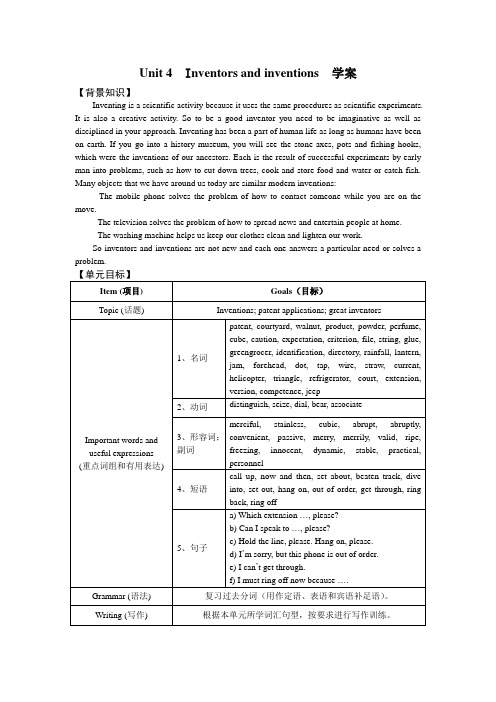
Unit 4 I nventors and inventions 学案【背景知识】Inventing is a scientific activity because it uses the same procedures as scientific experiments. It is also a creative activity. So to be a good inventor you need to be imaginative as well as disciplined in your approach. Inventing has been a part of human life as long as humans have been on earth. If you go into a history museum, you will see the stone axes, pots and fishing hooks, which were the inventions of our ancestors. Each is the result of successful experiments by early man into problems, such as how to cut down trees, cook and store food and water or catch fish. Many objects that we have around us today are similar modern inventions:·The mobile phone solves the problem of how to contact someone while you are on the move.· The television solves the problem of how to spread news and entertain people at home.· The washing machine helps us keep our clothes clean and lighten our work.So inventors and inventions are not new and each one answers a particular need or solves a problem.The First Period Warming up & SkimmingⅠ. Warming upTask 1 Look at the pictures below and discuss in pairs which pictures show inventions and which show discoveries.An amphibious car Stephenson’s“Rocket”DNA_______________ __________________ ________________Task 2 Work out the rules that will help you decide what a discovery is and what an invention is?A discovery is __________________________________________________________________. An invention is _________________________________________________________________.Task 3 Have a look at the following modern inventions and try to explain how they changed Discoveries Inventions1. __________ 1. Systems of delivering electrical light and heating to homes and offices2. Household machines for washing, ironing, keeping food cold, etc3. Computers, telephones, television, etc2. __________ 1. Airplane jet engines2. Air balloons, etc3. __________ Machines to help people with serious disease (like kidney failure)4. __________ 1. Body scanners to see whether you are ill2. Machines to tread illnesses (like cancer)Ⅱ. SkimmingTask 1 Do you know the stages every inventor must go through before they can have their invention approved? Inventing is a scientific activity and so follows similar stages to those used in research. Work out a suitable order.1. Applying for a patent ( )2. Finding a problem ( )3. Doing research ( )4. Testing the solution ( )5. Thinking of a creative solution ( )6. Deciding on the invention ( )Task 2 Skim the whole passage and get the main idea.The text narrates _________________________ and presents _____________________________ and applying for _____________________.Task 3 Divide the passage into several parts and find out the main idea for each paragraph.Part 1(para.1): _________________________________________________________________ Part 2(para.2-3): _______________________________________________________________ Part 3(para.4-6): _______________________________________________________________ Part 4(para.7-8): _______________________________________________________________Task4 SummaryWhat have you learnt in this period?1. I have learnt the following new words:______________________________________________2. I have learnt these useful expressions:______________________________________________3. I have learnt to talk about:________________________________________________________Task5 HomeworkFind out beautiful sentences and phrases you like most in the text.1.___________________________________________________________________________2.___________________________________________________________________________3.___________________________________________________________________________Teaching/Learning reflection:_______________________________________________________________________________ _______________________________________________________________________________The Second Period Reading & Language PointsⅠ. Share the sentences you like most with your partners.Ⅱ. ReadingTask 2 Read the text carefully and choose the best answer.1. How did the writer catch the snakes? ( )A. using something the snakes were interested to attract them into a trap.B. taking their habitat to another place.C. placing the snakes at a low temperature for them to sleep and then caught them.D. All the above.2. The writer was successful to catch the snakes in ________ attempt.A. the firstB. the secondC. the thirdD. every3. The following are used in the three attempts EXCEPT ________.A. perfumeB. a bowlC. jellyD. ice-cubes4. Why did cooling the snakes make them less active? ( )A. Because snakes are warm-blooded animals.B. Because snakes like high temperature.C. Because snakes are reptiles and their body temperature depends on the heat around them.D. None of the above.5. Which of the following may get a patent according to the text? ( )A. A computer programme.B. A new animal variety.C. A work of literature.D. A truly novel and useful invention.6. The purpose in writing this text is ________.A. to show us how to trap the snakes but not to kill themB. to tell people how to apply for a patent of the writer's new ideaC. to introduce the writer's new idea of trapping the snakes and her application for a patentD. to tell the readers how to get a new idea and make it a patent7. The biggest advantage of the writer's new idea is that ________A. it makes the snakes move slowlyB. it makes the snakes hardly bite usC. it is easier for us to kill the snakes without hurting ourselvesD. it is easier for us to catch the snakes without killing them8. Which statement is true according to the text? ( )A. The snakes were so sleepy in the second attempt that they couldn't bite the writer at all.B. Your product must be different from everybody else's if you want to receive a patent.C. The writer decided to send her invention to the patent office the moment she succeeded incatching the snakes.D. If an application for your product proves to be valid, you can get a patent immediately.Task 3Read and answer the questions.1. What was the mother upset about?2. Why was the writer happy to help her mother?3. Why did cooling make the snakes less active?Task 4 SummaryFill in the blanks according to the text.1______the writer called up her mother in the country on the phone, she learned that snakes came near their house and that the snakes seemed 2______ (make) their home near their house. The writer felt proud and considered 3______a chance for her to distinguish 4______by inventing something 5______would catch snakes but not harm them. She set about 6______ (research) the habits of snakes. She decided to cool them so that they could be 7______ (easy) caught. However, her first two plans were not successful. As a result, she had to attempt a 8______time, which helped her fulfill her aim successfully. She was 9______delighted that she was determined to send her 10______ (invent) to the patent office to get recognition for her successful idea.Ⅲ. Homework1. Review and retell the text.2. Discuss with your partner what the advantages might be of getting a patent.Ⅳ. Language pointsTask 1 Let us learn some useful expressions!1. Here was a chance for me to distinguish myself by inventing something merciful that would catch snakes but not harm them.这回我有机会来表现自己,我要发明某种东西,既可以把蛇捉住,而又不会伤害它们。
u4 invention教案
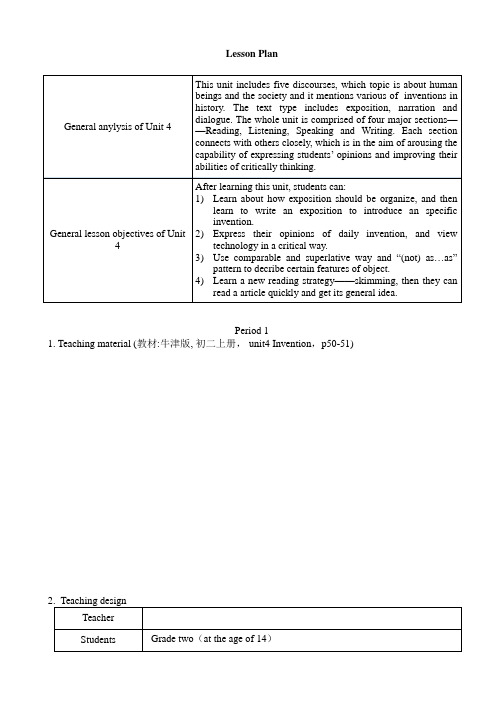
3)Use comparable andsuperlative wayand“(not) as…as”patternto decribecertainfeatures of object.
Prediction of learning difficulties
1.Content
There are some long and complicated foreign names, and many new words, which will make students distract easily when they are reading the passage.
General lesson objectives of Unit 4
After learning this unit, students can:
1)Learn about how exposition should be organize, and then learn to write an exposition to introduce anspecificinvention.
2)Phrase: a few thousand years ago, since then, over long distance, keep in touch, live without them
Lesson objectives
nguage ability:
1)Learn to talk about the effect of an invention in their daily lives.
lesson4
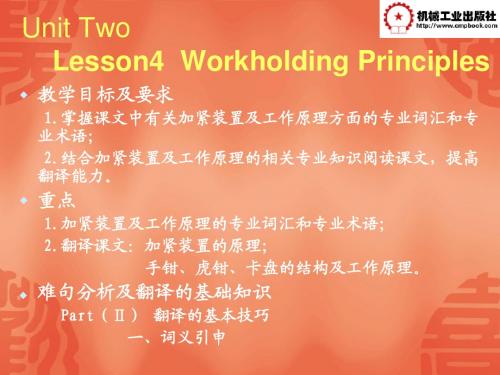
Example 3:
Part(Ⅱ) 翻译的基本技巧 在忠实于原文的前提下,如何摆脱原文形式的束缚,使 译文符合汉语语言的规范,这是翻译过程中的一个重要问题。 要解决这个问题,就需要掌握一定的翻译技巧。所谓技巧, 就是在翻译实践中总结出来的一些一般性的规律。掌握了这 些规律,就会对翻译过程起到很大的帮助作用。下面对科技 英语中常用的几种翻译技巧作一下简单介绍。 一、词义引申 翻译时常常遇到这样的问题,对某些很难从词典中找出 恰当的词义来表达的词。在这种情况下要使译文意思明确, 用词符合汉语习惯,就需要对词义进行引申。词义的引申往 往可从以下几方面来考虑。 (一)词义转译 翻译时遇到一些无法直译的词或词组,应根据上下文和 逻辑关系,引申翻译。
Language Points & Translating Techniques
Example 1:
The vise remains locked by the self-locking characteristic of the screw, provides means of attachment to a machine, and permits precise placement of the work. 台虎钳是由螺旋的自锁特性来保持紧锁的,它提供 了使其他部件附着到机床上的手段,从而确保加工时的 精确定位。 句中的remains,provides,permits为并列谓语, 进一步说明台虎钳的作用。
Text
Holding (chucking) a round workpiece
Text
Four-jaw Independent Chuck
1.They are attached to a variety of machine tools and are used to hold a workpiece during turning, boring, drilling, grinding, and other rotary operations. 2.Some are tightened manually with a wrench, others are power operated by air or hydraulic means or by electric motors. 3.On some chucks, each jaw is individually advanced and tightened, while others have all jaws advance in unison.
- 1、下载文档前请自行甄别文档内容的完整性,平台不提供额外的编辑、内容补充、找答案等附加服务。
- 2、"仅部分预览"的文档,不可在线预览部分如存在完整性等问题,可反馈申请退款(可完整预览的文档不适用该条件!)。
- 3、如文档侵犯您的权益,请联系客服反馈,我们会尽快为您处理(人工客服工作时间:9:00-18:30)。
4 1/20课程页码1 1/3ASME规范第VIII-1卷 -- 压力容器制造要求目标通过本课程的学习,你将了解制造基本的过程、材料的识别、准备和控制、以及适用于不同制造方法的要求及其应用。
课程概括Section VIII Div. 1的制造过程材料标记和追踪成形要求对中要求Section VIII Div. 1的焊接要求制造要求的顺序当涉及到制造时,规范中的所有Subsections都要运用,例如,Subsection A从UG-75开始给出了制造的一般要求,包括成形、不圆度、返修、材料的检验等要求。
Subsection B包含的要求涉及到制造方法,例如,UW篇时焊接要求,涉及到组对、焊缝余高、焊接工艺和焊工技能评定等要求。
Subsection C包含一些与材料类型有关的制造要求,如,UCS篇涉及到碳钢材料的成形、热处理等制造要求。
强制性附录为一些特殊结构给出了制造要求,如夹套容器、多层容器、非圆形容器。
当这些附录适用时,必须采用。
Code Cases对规范里没有涉及到的建造提供了规定。
Code Cases不是强制性的,但是,一旦运用就必须全面符合,并在数据报告中注明。
Section VIII Div.1制造流程制造考虑在制造之前或制造过程中需考虑:y人孔、吊耳、或其它装接件是否符合规范要求?它们的成形是否正确?y不圆度是否在规范允许的公差范围以内?y筒体与筒体、封头与筒体的对中错边量是否符合要求?y要求的斜坡过渡是否符合规范的要求?y焊缝余高是否在规定的范围以内?4 2/20课程页码1 2/3ASME规范第VIII-1卷 -- 压力容器制造要求影响制造流程的因素材料准备对于要用于规范制造的材料,必须:y核实材料是否可以用于制造;y核实材料是否具有可追踪性、标记是否正确;y正确下料及标记移植,对于需弯制成形的板材,应确保标记在外表面;y分割材料时,保持材料的标记;y去除气割氧化边缘;y开孔内缘倒角或倒圆;y焊接表面清理。
材料检验,UG-93UG-93规定的检验就时通常所说的“接收检验”,即材料在投入制造之前必须满足的要求。
4 3/20课程页码1 3/3ASME规范第VIII-1卷 -- 压力容器制造要求y板材:必须具有符合材料技术条件的材料试验报告或质量证明书;y其它材料:当材料技术条件规定在每件上要有标记时,每件材料必须标有Specification No.、Grade、Type和Class。
AI必须审查材料试验报告或质量证明书,核实材料按材料技术条件和QC手册的要求进行了标记识别。
制造厂必须在AI审查之前对材料进行了上述核查,另外,制造厂还必须检查材料尺寸、并提供必要检查样板。
材料的识别,UG-77UG-77给出了材料被接收后的控制要求,包括:y保持材料的识别标记,直到设备完工;y可使用编码标记代替原始标记,此编码标记必须经AI的审查认可;y可采用材料表或竣工图的方式记录所要求的标记,以保证在制造过程中、或容器完工后材料的可追踪性;y材料分割前或机械加工前,应移植编码标记或原始标记。
制造过程中材料的控制制造厂的QC手册应规定材料(包括焊材)控制的要求,包括:y材料保存;y发放;y检验;y标记识别;y返修。
成形加工的要求成形操作不得引起材料的性能发生不良的变化。
成形Subsection C对成形给出了一些限制,包括:课 程 页 码1 4/34 4/20 ASME 规范第VIII-1卷 -- 压力容器制造要求y 沿筒体纵缝不得有直边;y 必须满足UG-80或81的圆度要求; y 尺寸公差应符合设计的要求; y 成形后必须满足最小厚度要求; y 对接焊缝的对中要求必须满足。
规范允许几种成形方法,最常用的有冷成形和热成形两种。
无论采用哪种成形方法,都要避免产生沿纵缝的直边。
碳钢的成形对碳钢和低合金钢,规范给出了以下附加要求:y 不允许爆炸成形;y 如果材料在锻造温度下并经焊后热处理,允许采用爆炸成形;y 如果冷成形由无ASME 资格的厂家完成,必须提供符合UCS-79的证明。
冷成形件,UCS-79如果冷成形引起延伸率大于5%、并有以下情况存在,UCS-79要求成形后必须进行热处理:y 容器将用于有毒介质; y 要求进行冲击试验;y 成形前厚度超过5/8”(19 mm); y 厚度减薄量超过10%;y 成形温度在250°F(121°C)到900°F(482°)。
延伸率计算公式延伸率可用以下公式计算:对于双曲率成形件:延伸率(%) =)1(750R R R t f f − 对于单曲率成形件:延伸率(%) =Of f R R R t−1(50) 注意:当R o = ∞(平板),延伸率为5%的最小半径为:4 5/20课程页码1 5/3ASME规范第VIII-1卷 -- 压力容器制造要求双曲率成形件 = 15t单曲率成形件 = 10t筒体不圆度,UG-80UG-80规定了筒体的圆度公差,即最大内径与最小内径之差不得超过公称内径的1%。
公称内径指订购或设计内径。
Fig. 80.2给出了最大内径与最小直径差的例子。
筒体在管接头处的不圆度如果在距管接头1个开孔内径以内测量筒体的不圆度,可以另外增加开孔内径的2%。
例如:一个容器的内径为119”,在管接头傍边测得最大内径为120”,最小内径为118”,开孔的公称内径为7.625”。
最大内径 – 最小内径 = 2”1% (119) + 2% (7.625) = 1.34”因此,不圆度超差。
外压下筒体的不圆度,UG-80(b)按外压设计的容器必须:1. 满足UG-80(a)的不圆度要求;2. 偏离理想圆不超过UG-80(b)的要求。
从容器的外侧或内侧测量径向偏离理想圆的偏离值,最大正负偏差不超过Fig. UG-80.1查到的最大允许偏差值。
Figure UG-80.14 6/20课程页码1 6/3ASME规范第VIII-1卷 -- 压力容器制造要求应使用圆弧样板测量偏差值,圆弧样板的弦长为由UG-29.2得到的弧长的2倍。
加强板和管接头加强板成形后的形状应与连接处筒体或封头的外形一致。
管接头的端部也应加工成与筒体或封头外形一致的形状。
对接接头对接接头的定义为,两个被连接件基本在同一几何面内,夹角不超过30°。
焊缝类别焊缝类别是确定焊缝在容器上的位置,以下是Fig. UW-3,它示出了各类焊缝的位置。
4 7/20课程页码1 7/3ASME规范第VIII-1卷 -- 压力容器制造要求注:D类焊缝可以是角接焊缝,也可以是对接焊缝。
平封头上的焊缝为A类焊缝。
4 8/20课程页码1 8/3ASME规范第VIII-1卷 -- 压力容器制造要求焊缝对中要求,UW-33对接焊缝的边缘应对齐,最大错边量不超过Table UW-33为各类焊缝规定的限制。
Table UW-33焊缝类别截面厚度 (mm) A (mm) B, C & D≤ 12.7 1/4 t 1/4 t> 12.7 ~ 19.1> 19.1 ~ 38.1> 38.1 ~ 50.8> 50.8 1/16 t (Max. 9.5) 1/8 t (Max. 19.1)不等厚截面的对接焊缝UW-9规定,当两被焊接件的厚度之差超过较薄件厚度的1/4(最大为3.2 mm)时,就必须有3:1斜坡过渡。
此斜坡过渡可以用机械加工,也可用堆焊形成。
如采用堆焊法,必须满足UW-42的要求。
UW-9关于不等厚的斜坡过渡要求适用于球壳、筒体或封头上的焊缝。
当厚度之差不超过1/8”或1/4t(二者取小值),不要求3:1斜坡过渡。
UW-13焊缝结构中心线错边,Fig. UW-13.1对于封头与筒体的连接,中心线错边≤ 0.5(t h-t n)即(封头厚度 – 筒体厚度)。
为满足此要求,斜坡过渡可以放在内侧或外侧。
4 9/20课程页码1 9/3ASME规范第VIII-1卷 -- 压力容器制造要求Fig. UW-13.1,封头与筒体的连接直边长度Fig. 13.1除规定了中心线错边量外,还给出了直边长度的要求。
最小直边长度为3t h,但不超过1.5”,除非需要增长以满足斜坡过渡要求所需的长度。
注意,只有在需要有斜坡过渡时才要求有直边。
UG-32(i)说,如果封头的厚度等于或小于筒体的厚度,封头并不需要有整体直边。
4 10/20课程页码1 10/3ASME规范第VIII-1卷 -- 压力容器制造要求UW-13.4管接头与较小壁厚的管子连接UW-13.1封头与筒体的连接4 11/20课程页码1 11/3ASME规范第VIII-1卷 -- 压力容器制造要求UW-13.1不允许连接方式UW-13.14 12/20课程页码1 12/3ASME规范第VIII-1卷 -- 压力容器制造要求“Joggle Joint”Section VIII Division 1的焊接要求焊缝坡口的清理UW-32规定,坡口表面应清洁,无锈皮、锈、油、油脂、等其它有害物。
管接头与壳体的焊缝UW-16(c & d)要求,安放式管接头(abutting type)必须采用全焊透结构。
当全焊透结构不能用目视检查是否焊透,必须使用衬垫。
插入式管接头可以采用角焊缝或未焊透结构,但,必须从容器的内外进行焊接。
UW-16.1UW-20管子与管板的焊接UW-20条给出了三种管子与管板的焊缝结构,强度焊接、半强度焊接、密封焊接。
强度焊用来承受全部轴向载荷;密封焊仅用于作为胀接的补充焊接,以保证密封;半强度焊是根据在实际设计条件下机械和热膨胀载荷来确定其强度的。
下料、装配和对中规范中提到下料、装配和对中要求的条目有好几条,如:y切割边必须光滑、清洁。
(UW-31)y点焊焊缝、无论是去除,还是保留,都必须使用评定过的焊接工艺。
(UW-31)4 13/20课程页码1 13/3ASME规范第VIII-1卷 -- 压力容器制造要求y保留于焊缝中的点焊焊缝应由评定过的焊工施焊。
(UW-31)y非受压件跨过受压焊缝与受压件相焊时,非受压件必须开槽以避让焊缝、或将受压焊缝磨平。
(UG-82)y当受压件焊在受压焊缝上时,焊缝必须磨平。
(UG-82)UW-27焊接方法UW-27规定,用于Section VIII Division 1的焊接方法有以下几类:UW-27(a) 弧焊或气焊UW-27(b) 压力焊UW-27(d) 销钉焊UW-27(e) 电渣焊UW-27(f) 电气焊纵缝的排列UW-9(d)对容器各筒节纵缝之间的排列规定了要求,即要求纵缝相互错开,相距至少是较厚板厚度的5倍,否则,焊缝两侧必须至少4”(102 mm)要求进行RT检验。
焊接限制Section VIII中关于焊接的两项限制是:y销钉焊仅用于非受压/非承载件的焊接;y电渣焊仅用于铁基和UW-5(d)给出的奥氏体钢。
